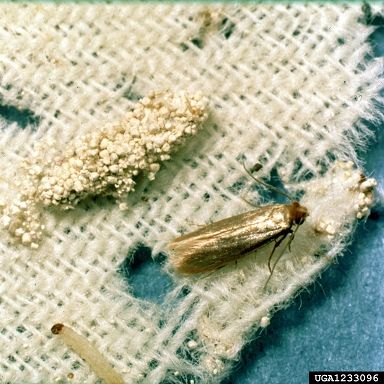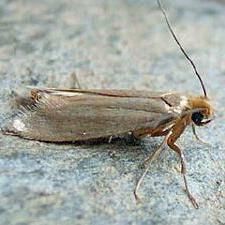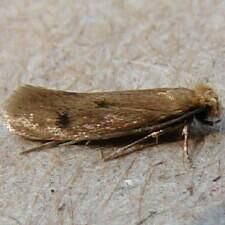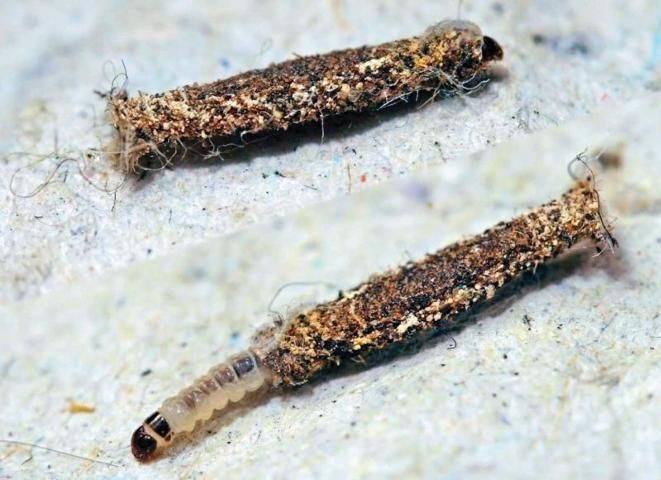
The most commonly encountered clothes moths are the webbing clothes moth and the case-making clothes moth, which are in the family Tineidae. Clothes moths are major pests because their feeding habits damage fabrics and other items made of natural fibers. Clothes moth larvae have the ability to digest keratin, which is a principal protein in wool, feathers, fur, hair, upholstered furniture, animal and fish meals, milk powders, and most animal products, such as bristles, dried hair, and leather. Larvae will also infest or feed on lint, dust, paper, cereal products and materials soiled with oil, dried meat extracts, and insect remains. Clothes moth larvae can feed on mixtures of natural and synthetic fabrics (Figure 1). However, they cannot feed on materials made of pure synthetic fibers. In nature, clothes moth larvae have been found infesting pollen, hair, dead insects, and dried animal remains.

Credit: Clemson University
Adult moths do not feed on fabrics, only the caterpillars do. Fabrics damaged by clothes moth larvae have irregularly shaped holes eaten through them by the tiny white caterpillars (Figure 1). Damaged fabrics often have silken cases or silken threads along with fecal pellets on the surface that ruin the appearance of the product. Adult moths may be found running over the surface of infested garments or materials. Unlike many other moths, adults are not attracted to lights and will usually fly (males) or crawl (females) to a darkened area to hide away from lights as fast as possible.
Description
Adult webbing clothes moths are small and yellowish-golden. Case-making clothes moths are a similar size, but their front wings are more brownish than those of the webbing clothes moths. The adults vary in length from ¼ inch to ½ inch. When the moth is at rest, their wings are held tentlike at an angle over the abdomen. The head and front wings of the webbing clothes moth are golden or yellowish; the wings do not have spots (Figure 2). The hairs on the head of the case-making clothes moth are lighter colored than those of the webbing clothes moth, and the front wings have three dark spots (Figure 3), which may be rubbed off with wear.

Credit: MS State University

Credit: MS State University
The larvae of webbing and case-making clothes moths are white with a dark head capsule. They spin webbing as they feed. Case-making clothes moth larvae create a silken tube (case) to protect them from the environment and natural enemies. The case-making clothes moth larvae do not leave the silken tubes; they stay inside and grow. The tubes created by the webbing clothes moth are attached to and often located in dark, protected areas such as seams or hems. Therefore, the larvae of the webbing clothes moth are stationary and feed in one area. The case made by the case-making clothes moth is not attached to the fabric. The larvae drag the case along and are relatively mobile. The case-making silken tube (Figure 4) takes on the coloration of the fabric eaten by the larvae.

Credit: MS State University
Life Cycle
The life cycle of the clothes moth can last from two months to two years, with males outliving females and continuing to mate throughout their lives. The adult female lays eggs singly or in groups on products that the larvae will consume, but these eggs are not glued very strongly and can easily be dislodged. Each female moth can deposit from 100 to 150 eggs, depending on temperature, and eggs will hatch in about five days. On emerging from the egg, the larva is white and about 1/16 inch (16 mm) long. It can grow to about 1/3 inch (85 mm) when fully grown. The larval mouthparts are modified for biting food and for spinning silk. The larval stage varies greatly according to environmental conditions such as temperature and food supply. The larvae live in cases that enlarge as they grow. When fully grown, the larva stops feeding and spins a tough, spindle-shaped cocoon in which to pupate. The pupation period lasts from eight to 10 days in summer and three to four weeks in winter.
Management
Prevention and Inspection
The most important method of clothes moth control is good housekeeping. Clothes moths can be controlled by various methods, including periodic cleaning, proper storage of susceptible articles, dry cleaning and laundering, freezing, heating, and/or fumigating with dry ice. Clothes moths most often are found on items that are not stored properly. All susceptible articles should be brushed and cleaned periodically, especially items that will be stored for any length of time, and placed in airtight containers. Dry clean items, such as woolen sweaters, before they are stored. The vacuum cleaner is a good tool for regularly removing woolen lint or hair from floors, shelves, and drawers.
Also, inspect areas for the presence of clothes moths, such as attics, ventilation ducts, and other areas where insects and dust accumulate. Clothing bags, cedar closets, and cedar chests only provide protection when stored materials are free from infestation. Eastern red cedar contains an oil that is able to kill only small larvae with no effect on large clothes moth larvae. Pheromone traps are an easy-to-use technique to monitor for webbing clothes moths and trap the male moths.
Chemical Control
Some woolen fabrics and carpets can be mothproofed by the manufacturer. However, very few susceptible products are mothproofed today. Furnishings and carpets made entirely of synthetic fibers are not affected.
Crack-and-crevice or spot treatment with insecticides may be necessary when clothes moths become established in the home. Apply sprays according to label directions, and do not apply directly to clothing. Sprays are effective when properly applied to surfaces as spot treatments. Most sprays that list clothes moths on their label contain pyrethrins, which provide quick knockdown of clothes moths. Sprays should be directed to all known or suspected breeding places. Clothing should be removed from closets and drawers before spraying interior surfaces. Some insecticides have an oil base and should not be sprayed on silk, rayon, or other fabrics that stain easily.
For severe infestations, it may be necessary for a pest control company to fumigate the structure. Tight closets, trunks, or chests can be mothproofed by application of moth balls at the rate of 1 pound per 50 cubic feet of space. Moth balls contain naphthalene and should be kept away from children and pets.